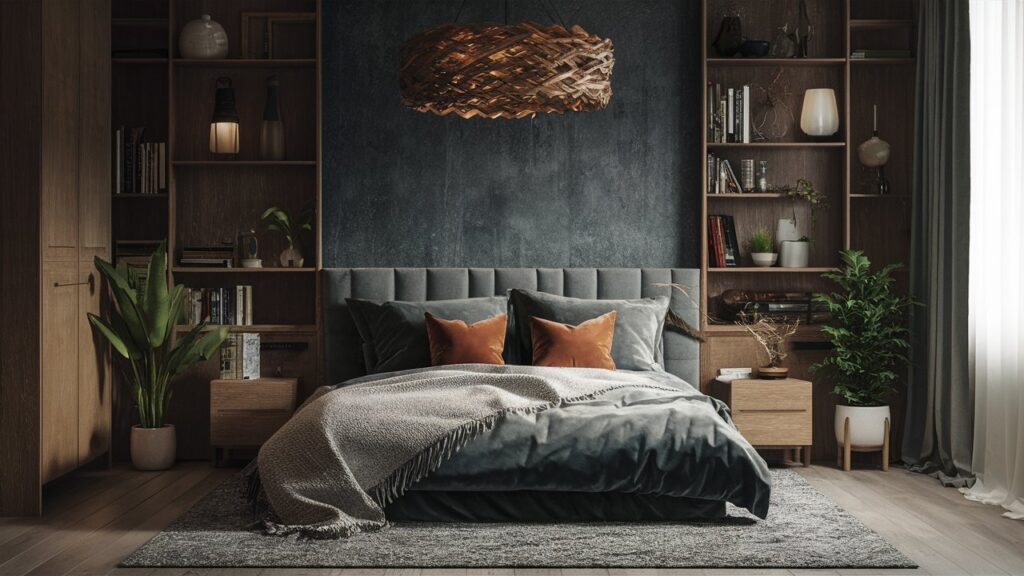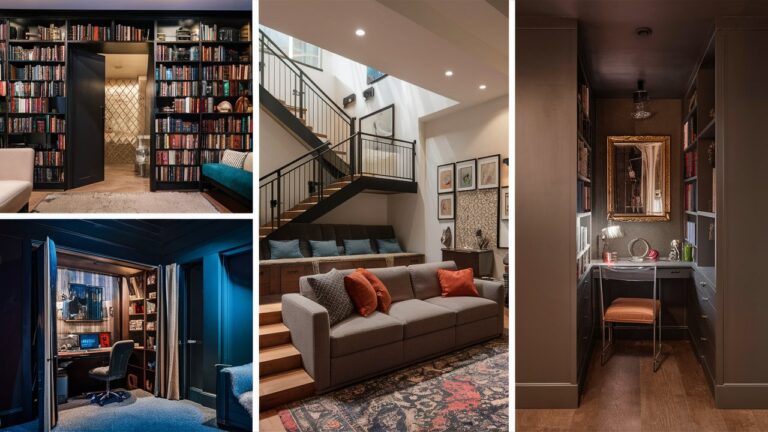Introduction
The allure of secret rooms has captivated imaginations for centuries, from medieval castles with concealed passages to modern homes with hidden panic rooms. These spaces blend practicality with a touch of magic, offering solutions for storage, safety, creativity, or pure whimsy. Whether you’re a fan of mystery novels, a parent seeking clever storage, or a homeowner prioritizing security, secret rooms can transform your living space into something extraordinary. In this article, we’ll explore innovative secret room ideas that merge functionality with intrigue, diving into design tips, inspiration, and answers to common questions.
1. Bookcase Doors: Classic Entryway to Hidden Spaces
A revolving bookcase door is the quintessential secret room feature, combining nostalgia with practicality. This design involves installing a bookshelf on a hidden hinge or sliding mechanism, allowing it to swing open to reveal a hidden room. Use sturdy, floor-to-ceiling shelves filled with real books or decorative items to maintain the illusion. This idea works perfectly for home offices, reading nooks, or even safe rooms. For added authenticity, incorporate a discreet latch or a magnetic lock triggered by a specific book. The key is to ensure the mechanism operates smoothly while blending seamlessly with your existing décor.
2. Concealed Playrooms: Fun and Functionality for Kids
Transform an underutilized closet or corner into a hidden playroom for children. By installing a lightweight sliding wall panel or a camouflaged door painted to match the surrounding walls, you can create a whimsical space that keeps toys out of sight. Add soft lighting, colorful cushions, and wall-mounted storage to maximize the area. This design not only sparks children’s imaginations but also helps maintain a clutter-free home. For older kids, consider a loft-style hideaway accessible via a ladder or trapdoor, fostering a sense of independence and adventure.
3. Under-Stair Storage: Maximizing Unused Space with Secret Compartments
The space beneath a staircase is often overlooked, but it’s ideal for creating hidden storage or a compact secret room. Install a custom-built door that mirrors the staircase’s design, or opt for drawers disguised as wall panels. This area can house anything from seasonal decorations to a cozy pet nook. For a more ambitious project, carve out a mini-library or a wine cellar with climate control. The key is to prioritize accessibility—ensure the door or drawers open smoothly without obstructing foot traffic.
4. Hidden Panic Rooms: Safety Disguised as Décor
A panic room doesn’t have to look utilitarian. Modern designs integrate these safe spaces into your home’s aesthetic. For example, a floor-to-ceiling mirror could conceal a reinforced door leading to a secure room equipped with communication devices, emergency supplies, and ventilation. Alternatively, disguise the entrance as a wardrobe or a section of kitchen cabinetry. Work with a security expert to ensure the room meets safety standards while maintaining visual cohesion with your home’s style.
5. Secret Walk-In Closets: Luxury Behind Closed Doors
Elevate your storage game by hiding a walk-in closet behind a decorative wall panel or a sliding barn door. This works particularly well in bedrooms where space is limited. Use a full-length mirror or a tapestry as the “door,” and outfit the interior with custom shelving, lighting, and a vanity. Not only does this add a touch of luxury, but it also keeps clothing and accessories organized and out of sight.
6. Home Theater Hidden Behind a Painting
For movie enthusiasts, a hidden home theater offers both practicality and drama. Mount a large, framed painting or tapestry on a motorized track that slides aside to reveal a projector screen and seating area. Soundproof the walls and install blackout curtains to enhance the cinematic experience. This design is perfect for basements or spare rooms, creating a dedicated entertainment zone that disappears when not in use.
7. Secret Garden Rooms: Bringing the Outdoors Inside
Blur the line between indoor and outdoor spaces with a hidden garden room. Install a glass-paneled door covered by ivy or a vertical garden wall that pivots to reveal a sunroom or conservatory. Fill the space with potted plants, a water feature, and natural materials like wood and stone. This idea is ideal for homeowners seeking a tranquil retreat or a unique entertaining area.
8. Hidden Library with Sliding Ladder Access
Channel your inner Belle from Beauty and the Beast with a floor-to-ceiling library hidden behind a sliding bookshelf. Incorporate a rolling ladder for both functionality and charm. This design works well in studies or living rooms, offering a quiet escape for reading or working. Add a discreet door within the shelves to access an even more secluded nook, perfect for meditation or creative projects.
9. Art Studio Behind a Mirrored Wall
Artists and crafters can create a private studio behind a mirrored wall or sliding glass panels. The reflective surface camouflages the room while making the main space appear larger. Outfit the studio with ample lighting, storage for supplies, and a sturdy worktable. This setup keeps creative messes contained and inspires focus during projects.
10. Wine Cellar Behind a Rotating Wall
A rotating wall section can conceal a temperature-controlled wine cellar, adding sophistication to your home. Choose a wall in a dining room or kitchen, and install a motorized mechanism that spins to reveal shelving for bottles. Pair with mood lighting and a tasting table for an immersive experience. This design is both functional and conversation-starting.

11. Hidden Bathroom Behind a Bookshelf
Maximize space in small homes by disguising a powder room behind a bookshelf. This works well in studios or apartments where every square foot counts. Ensure plumbing is accessible and opt for a compact, space-saving toilet and sink. Decorate the shelf with lightweight items to make opening the door effortless.
12. Kids’ Study Nook Behind a Wall Panel
Create a distraction-free homework zone by tucking a study nook behind a wall panel in a child’s bedroom or playroom. Fit the space with a desk, shelves, and task lighting. Decorate the panel with chalkboard paint or removable decals to make it interactive.
13. Home Office Behind a Sliding Barn Door
With remote work on the rise, a hidden home office helps maintain work-life balance. Use a sliding barn door painted to match your walls, or camouflage it with a gallery of framed photos. Soundproof the room and include built-in desks and storage for a professional setup.
14. Secret Attic Hideout
Convert your attic into a secret lounge or hobby room. Install a pull-down ladder or staircase hidden in a hallway ceiling. Decorate with string lights, cozy seating, and memorabilia for a nostalgic vibe.
15. Safe Room Behind a Fireplace
For a dramatic security feature, build a safe room behind a faux fireplace. The mantel can swing open to reveal a reinforced space with emergency supplies. This design adds charm while prioritizing safety.
Conclusion
Secret rooms are more than just architectural novelties—they’re versatile solutions that enhance your home’s functionality, safety, and aesthetic appeal. From hidden libraries to panic rooms disguised as art installations, these ideas invite creativity and practicality. By tailoring your secret space to your lifestyle, you can craft a home that’s as unique as it is functional.
Frequently Asked Questions (FAQs)
- Are secret rooms expensive to build?
Costs vary based on complexity. Repurposing existing spaces (e.g., under stairs) is affordable, while panic rooms or rotating walls require professional installation and higher budgets. - How do I ensure a secret room is safe?
Consult architects or security experts for structural integrity, ventilation, and emergency exits, especially for panic rooms. - Can I DIY a secret room?
Yes! Simple projects like bookcase doors or under-stair storage can be DIYed with basic tools. Complex mechanisms (e.g., rotating walls) need professionals. - Will a secret room affect my home’s resale value?
It can be a selling point if designed thoughtfully. Highlight functionality (e.g., extra storage or a home office) to appeal to buyers. - How do I maintain a hidden door’s mechanism?
Regularly lubricate hinges or tracks and test electronic components. Choose durable materials to minimize wear and tear.
Unlock the potential of your home with these secret room ideas—where imagination meets innovation!
